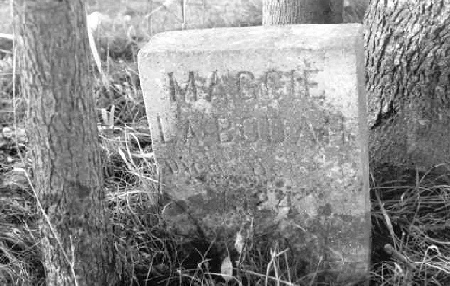
For Some, Poor Farm was the End of the Line
-Page 2-

|
The Poor House was a large, rambling structure that could house up to two-dozen individuals, as shown in this undated photo. The house had deteriorated by the 1940ís and was torn down shortly after the farm closed and sold in 1945. Only part of the foundation remains today. |
Life on the farm does not appear to have been easy. The residents, if able, were expected to perform farm work to defray the costs of their upkeep. Perhaps there was a reason why so many had "exhaustion" listed as a contributing cause on their death certificates.
The population of the farm varied from a few to two-dozen. Poor Farm overseer Ira Fike reported to the board in November of 1883 that he had six "inmates" at the start of the year: four males and two females, "one female being partially insane the other being foolish."
In the course of the year, 15 other individuals had passed through his doors, according to Fike. Four were adopted; three were taken in by relatives, and one, Ernst Hildebrant, 24, died of diabetes.
The June 1, 1905 census showed an overseer, his wife and three children, a hired hand and 12 inmates to be living at the farm. Eight of them had been born overseas, Germany and Poland, two were women and one was a nine-year-old orphan. Within the year, half the men had died.
Occasionally the "Clark County Republican," the forerunner of the "Clark County Press," would comment about the residents of the farm with a mixture of curiosity and pity.
"Robert Porter died in the Clark County Poor House January 20, Ď84, of general prostration and heart disease at the age of 61 years," the Republican reported. "Mr. Porter was admitted into the Poor House July 10, í83, and during the whole time, had been confined to his bed, not being able to sit up, and did not take but one meal at the table while at the Poor House. Overseer Fike, who gives these particulars, says Mr. Porter was very patient, never complaining and always pleasant, waiting patiently for the last."

Weeds and even trees dug themselves into the grave of
Maggie La Bodah, laid in a pauperís grave when she died in 1924.
The Republican was less charitable towards another individual that same year, who was healthier in body.
"Tuesday a person with a loathsome disease of bad character applied to Poor Commissioner Wm Campbell for assistance. That evening overseer Fike loaded the youth into the Poor Farm Wagon and took him over the hill. An attempt to get him boarded in the city was unsuccessful. His advent into Poor Farm Society makes the total number of paupers 10," commented the Republican.
It was the advent of welfare programs and the Clark County Health Care Center at Owen, providing other means of supporting the poor and unhealthy, that made the Poor Farm obsolete. After years of being self-supporting, the facility ran a $2,500 operating deficit in 1932 and continually lost money throughout the decade. Facing the prospect of $1,500in repairs to the Poor House boiler, the county board voted unanimously to sell the farm in 1944 and completed the transaction in February of 1945. The large, dilapidated house was torn down shortly after the sale.
The cemetery and old Poor farm grounds are located on County Trunk Highway C, a few miles northeast of Neillsville in the Town of York. The farm is now operated by the Walter Spencer family, which still uses the old barn.
Although the county retained the right to maintain the cemetery when the farm was sold, the land is privately owned and used for crops and pasture. Anyone wanting to visit the site, which is not visible from the road, should obtain permission from the landowner. Many of the older tombstones are badly weathered and difficult to read.
[Return to page 1] [Visit the York Cemetery]
|
© Every submission is protected by the Digital Millennium Copyright Act of 1998.
Show your appreciation of this freely provided information by not copying it to any other site without our permission.
Become a Clark County History Buff
|
|
A site created and
maintained by the Clark County History Buffs
Webmasters: Leon Konieczny, Tanya Paschke, Janet & Stan Schwarze, James W. Sternitzky,
|